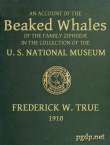قراءة كتاب The Beaked Whales of the Family Ziphidae An account of the Beaked Whales of the Family Ziphiidae in the collection of the united states museum...
تنويه: تعرض هنا نبذة من اول ١٠ صفحات فقط من الكتاب الالكتروني، لقراءة الكتاب كاملا اضغط على الزر “اشتر الآن"

The Beaked Whales of the Family Ziphidae An account of the Beaked Whales of the Family Ziphiidae in the collection of the united states museum...
class="center">mm.
- a The size of the teeth makes it quite certain that it is an adult female.
- b End of beak broken off about 30 mm. from tip.
- c Right side. Add 31 mm. for breakage.
- d In median line.
- e At middle.
- f Between “suprafrontal processes of max.”
- g Grieg’s fig., p. 18, shows 44 mm.
- h From Grieg’s fig., p. 18.
- i “Length of ramus.” Length of mandible=699 mm.
- j In Trans. Roy. Soc. Edinburgh, vol. 26, 1872, p. 776.
MESOPLODON DENSIROSTRIS (Blainville)?
- Delphinus densirostris Blainville, Nouv. Dict. Hist. Nat., 2d ed., vol. 9, 1817, p. 178.
- Ziphius seychellensis Gray, Zoöl. Erebus and Terror, 1846, p. 28.
The skull of the specimen from Annisquam, Mass., (Pl. 1, fig. 2) is, I regret to say, in rather poor condition. It is broken in the left orbital region, and all the bones, especially those of the beak, are warped by weathering. The proximal extremity of the left premaxilla is lacking and also the tip of the beak.
The skull is obviously that of a young animal, as all the sutures are open and the surface of the occipital condyles is pitted, owing to imperfect ossification.
Although the dimensions of the skull, with a few exceptions, agree well with those of young specimens of M. bidens, as shown by the foregoing table (p. 8), certain differences stand out conspicuously. The most salient of these is the depth of the beak as a whole and the depth and shape of the rostral portion of the premaxillæ. The latter portion of the premaxillæ instead of being low, with a straight inferior margin, is very high, with the inferior margin strongly convex. At the middle of the beak the premaxillæ are higher than the maxillæ on which they rest. It is true that the shape of the beak varies greatly with age in bidens and other species of Mesoplodon, but I do not find any evidence that such a change as is here indicated takes place in bidens. The form of the beak and of the rostral portion of the premaxillæ is that of M. densirostris.
The beak is almost as broad at the base as in bidens, but the lateral free margin of the maxilla anterior to the anteorbital notch instead of continuing along the side of the beak nearly to the tip, as in bidens, ends at a point


